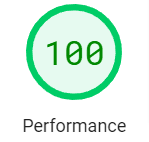As we all know, Google’s goal is to return the best results possible for any given search query. It comprises hundreds of signals, including core on-page ranking factors such as keywords in title tags and Meta descriptions, links, content, the website’s load speed, and more.
Over time, Google has released numerous updates to their ranking factors (almost daily), and these commonplace updates mean that web admins need a lot of patience to stay up to date with them all. The main point here is that every one of these factors contributes to the overall user experience – meaning that the website has to look good AND function well.
When you see an update announced like “page experience,” it means that there will be some algorithm changes based solely on the appearance/consumer experience on your site.
Below are SEO Incs Current Web Core Vitals Scores

What is Page Experience?
Page experience refers to signals measuring users’ experience when interacting with a web page above its information value. These signals are defined as Core Web Vitals — a collection of metrics that measure critical aspects of the user’s experience — and other factors, including safe browsing, mobile-friendliness, HTTPS security, and intrusive ads guidelines.
In other words, Google uses these factors to inform ranking
- Loading — The time it takes for content to display
- Interactivity — The time it takes for users to interact with content
- Visual stability — The time it takes for content to stay stable while loading
- Mobile-friendliness — How well a page works on mobile devices
- Safe browsing — if a site contains malicious or deceptive content
Google fully rolled out the mobile version of their page experience update in September 2021.
Given the desktop update, SEOs must technically optimize their sites to deliver the best user experience and unlock higher ranking Google search results.
How Does Page Experience Work for Mobile
As previously announced, Google Search will begin using page experience as its ranking signals. When Google’s page experience update rolls out on desktop later this year, all pages will be assessed and scored on-page experience metrics using the same standards as they are on mobile. Page experience is already a ranking factor for mobile results. It will also become a ranking factor for desktops sooner or later.
Page Experience in Google Search Console Reports
Last year, Google introduced their Page Experience report in Search Console and a new section called Core Web Vitals in PageSpeed Insights. These tools can help webmasters and SEO professionals determine how they should improve their page experiences, including Core Web Vitals scores on their websites.
Recently, Google announced that they had updated their Page Experience report to include data from users’ desktop devices and mobile devices.
What Page Experience Means for Desktop SEO
- Google will serve mobile pages to desktop searchers without making any changes.
- Google’s page experience score is going to affect the search results, and ads will prioritize pages with better page experience scores
- After the first quarter of 2022, this signal will be more significant and may cause pages with good page experience to rank higher than pages with poor page experience
Why is Google Rolling out Page Experience for Desktop?
A few years ago, Google introduced metrics to measure the quality of user experience (UX) on mobile web pages, aptly named Core Web Vitals. These metrics include Largest Contentful Paint (LCP), Cumulative Layout Shift (CLS), and First Input Delay (FID).
Google recently announced that these same metrics would be used to evaluate the “page experience” for desktop web pages. Meaning if you have a poor UX on mobile, your desktop rankings might be affected too.
Preparation Tips for the 2022 Update to Desktop Page Experience
While Google has yet to announce the exact weight these new ranking factors will carry, you must start optimizing now so that you can improve your UX before sweeping changes come to page rankings. Here are some tips and tools that you can use to get started:
Ask your development and SEO teams to measure and report on your site’s current Core Web Vitals metrics using tools like PageSpeed Insights, Chrome UX Report, or Lighthouse.
Get feedback from users about how fast their experiences are on your site using tools like the CrUX Dashboard or Chrome UX Report.
Ask your SEO team to evaluate your current web core vitals site scores (as measured by Google Search Console) and where it has room for improvement.
Your SEO team can also monitor how these changes may impact rankings for your site over time by comparing your site’s rankings before and after the update goes live.
If you see poor performance scores, prioritize fixing those issues by working with your development team.
Optimizing Web Core Vitals Scores

Largest Contentful Paint (LCP): LCP measures the time from when the page starts loading to when the largest content element is displayed in the viewport. Aim for an LCP score of not less than 2.5 seconds.
First Input Delay (FID): FID measures how long your site takes to respond to user input in real-time and helps identify bottlenecks in your site’s responsiveness. The wait time should not exceed 100 milliseconds.
Cumulative Layout Shift (CLS): CLS quantifies how often users experience unexpected layout shifts associated with user interactions like clicks or taps. Aim for a CLS of not more than 0.1.
HTTPS: Safe browsing is the most basic requirement for a great page experience. A site that’s not secure risks being flagged as unsafe by browsers, which will damage consumer trust. The HTTPS protocol protects web pages from data interception and tampering by malicious actors.
Interstitials: Intrusive pop-ups, such as those covering most of the screen or showing up right after users click on a page, are frustrating and can increase bounce rates. Intrusive interstitials may also block users from seeing important content on a page, making it difficult to interact with your site. More Web Core Vitals and Search Engine Optimization is on our site.
Notes:
Google Page Experience is a new Google ranking factor that calls for an in-depth site audit and a more user-friendly approach to web design development and search engine optimization (SEO).
Unfortunately, many websites are unprepared and will struggle to keep up with the speed and agility it takes to rank first.
SEOinc can help you optimize your desktop and mobile page experience with the speed and agility required for ranking competitiveness. Our dedicated teams of internet marketing experts have experience working with clients to ensure that their websites are up to Google’s standards and algorithm updates.

